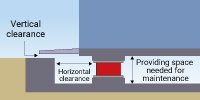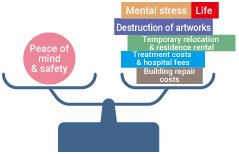This website uses cookies for a better browsing experience.
If you agree to the use of cookies, please click the "Agree" button.
Please refer to the Privacy Policy regarding the use of cookies on this site.
Products for buildings
Seismic Isolation
- What is the life span of a seismic isolator?
-
Laminated rubber can last for 60 to 80 years in an accelerated degradation test via heating.
In addition, there are examples in Australia where rubber bearings installed on bridges about 100 years ago are still in use today, with no problems at all.
- Are pipes for gas and water safe?
-
Put your mind at ease. Pipes for natural gas, water, sewage, electricity, etc. are connected with flexible joints that have enough leeway to prevent damage due to shaking.

Water and sewage pipes installed

Installation of natural gas pipes
- After an isolator moves during an earthquake, does it return to its original position?
-
The seismic isolators are designed to return to about their original position, so rest assured.
- Can they handle vertical shaking from an earthquake?
-
Seismic isolators that are typically used in the foundation today are not designed for vertical movement. Objects fall over because they are greatly affected by lateral shaking. If, for example, you shake an object on a board vertically, it will not fall easily, but if you shake it horizontally, it will immediately fall. During an earthquake, building sway is greatly amplified in the horizontal direction, but seismic isolation greatly reduces this horizontal sway. This minimizes the possibility of equipment toppling over even during vertical shaking. The same can be said for buildings.
- Are seismic isolators fireproof?
-
Seismic isolators are normally installed in the seismic isolation layer below the lowest floor of the building and are not fireproof since there is nothing to cause a fire and no combustibles are present. If, however, laminated rubber is installed between floors or in other locations where there is a fire hazard, fireproofing such as a fireproof coating is required.
- How much does a seismic isolator move during an earthquake?
-
That depends on the earthquake and the seismic isolator used, but it is about 30-40 cm per side for a major earthquake. In seismically isolated buildings, there is a clearance (gap between the building and the ground) of about 50 to 60 cm to allow for this amount of movement.

Building perimeter clearance

During deformation
- Isn’t seismic isolation more expensive?
-
Seismic isolators are normally installed in the seismic isolation layer below the lowest floor of the building and are not fireproof since there is nothing to cause a fire and no combustibles are present. If, however, laminated rubber is installed between floors or in other locations where there is a fire hazard, fireproofing such as a fireproof coating is required.
- How is a seismically isolated building maintained?
-
Seismic isolators do not need to be replaced due to their durability, but regular inspections are recommended for greater reliability and to maintain safety. In addition, an ad hoc inspection is required in the event of an earthquake with an intensity of 5 or greater.
- Is the seismic isolation layer always installed underground?
-
Depending on the function and use of the building, various systems can be selected. This includes the basement as well as floors above ground and between floors as shown in the figure. The entire site can also be seismically isolated as a site for local disaster prevention.


- What are the advantages of seismic isolation besides safety?
-
Seismic forces transmitted to the building can be reduced, dramatically increasing design flexibility for complex building shapes and layouts, larger openings, and glass structures.
Vibration control
- Isn’t vibration control quite expensive?
-
Various costs are involved in the conversion to vibration control, including the devices, but vibration control is not that expensive overall given improved safety to withstand damage during an earthquake and the cost of repairs afterwards.
- What are the other advantages of vibration control besides safety?
-
Vibration control can greatly reduce building sway, so it prevents wind sway in high-rise buildings as well as sway during an earthquake, dramatically improving livability. It also allows for greater design freedom in high-rise buildings, such as large open spaces in event halls, high ceilings, and large openings.
- How is a vibration control device maintained?
-
Materials such as viscous materials and lead that are used in our vibration control devices have excellent weather resistance and durabilityand they maintain consistent resistance to vibrations with no loss in performance despite repeated actuation, so they do not need to be replaced except in the event of a fire.
Residential products
Here, your frequently asked questions about seismically isolated homes are answered in the form of a FAQ.
- Isn’t a seismically isolated house quite expensive?
-
The total cost is lower.
The initial cost of a seismically isolated home is higher, but there is no substitute for the peace of mind that comes with knowing that “our home is fully protected against a major earthquake.”Once the damage is done, the reality of repairing a home, replacing furniture and appliances, and treating injuries is staggering. Even if you are financially compensated for a disaster through earthquake insurance or other means, returning to life as normal will be a massive struggle. That is why we need to change our mindset from “I’ll fix it if it collapses” to a mindset of “Let’s avoid a building collapse in the first place.”When those aspects are considered on the whole, the life cycle cost of a seismically isolated home is lower.

- Are you sure my home will be okay if a major earthquake actually strikes?
-
Swaying is reduced to about 1/3.
The safety of seismically isolated buildings has been proven by the fact that seismically isolated buildings in the area where the Great Hanshin-Awaji Earthquake struck sustained no damage whatsoever, including to their interior. In addition, Oiles Corporation conducts numerous performance tests to maintain the durability and reliability of its seismic isolators.

The natural period The time that a building takes to sway once. Each building has a different natural period. The longer the natural period, the slower the shaking. Response acceleration During an earthquake, a building shakes according to its natural period. Response acceleration represents the intensity and magnitude of the shaking. - How long does a seismic isolator last?
-
Seismic isolation performance is maintained for more than 60 years.
- Can an isolator be installed in a 3-story apartment building?
-
It can. Seismic isolators are not selected for only certain buildings.
- Does it not sway with the wind?
-
It does not sway during normal winds.



